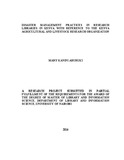| dc.contributor.author | Aburuki, M. K | |
| dc.date.accessioned | 2017-01-11T13:24:43Z | |
| dc.date.available | 2017-01-11T13:24:43Z | |
| dc.date.issued | 2016 | |
| dc.identifier.uri | http://hdl.handle.net/11295/100359 | |
| dc.description.abstract | Reducing disaster vulnerability is through mitigation. The purpose of the study was to
assess disaster management approaches applied by the organization and suggest possible
solutions on how to minimize disaster damage. The study specific objectives were to:
establish the appropriateness of facilities available to manage and handle disaster incidents
in research libraries, find out strategies and practices put in place to deal with disaster
incidents, examine mitigation methods used to manage and support disaster risks, and
determine the role of management in support of disaster preparedness in research libraries.
The study used integrated disaster management model in relation to mitigation,
preparedness, response and recovery against natural or man-made disasters. The study
comprised a total representative sample population of 140 respondents from nine centres
of Kenya Agricultural and Livestock Research Organization. The study adopted
descriptive research design and data and information was collected using questionnaires
and interview schedules. Quantitative data was analyzed using Microsoft Excel application
and presented in form of charts, tables of frequencies and percentages while qualitative
ones were coded through Statistical Package for Social Sciences. The study findings
revealed that there is lack of institutional capacity to in terms of adequate financial
resources. In addition the findings found out that Majority of personnel involved in disaster
management were not adequately trained. The study also indicated that there were no
strategies put in place nor adequate tools to implement planning and prevention to manage
disasters. The study recommends that the institution needs create awareness for both the
staff and clients in matters of disaster prevention, funding by the organization, staff
training, policy formulation and implementation and routine risk assessment. The study is
useful to professionals and policy makers involved in disaster management at all levels in
the organization for disaster reduction to be achieved. This is significant in enhancing
awareness and to a greater extent improve disaster management facilities | en_US |
| dc.language.iso | en | en_US |
| dc.publisher | University of Nairobi | en_US |
| dc.rights | Attribution-NonCommercial-NoDerivs 3.0 United States | * |
| dc.rights.uri | http://creativecommons.org/licenses/by-nc-nd/3.0/us/ | * |
| dc.subject | Disaster Management Practices In Research Libraries In Kenya With Reference To The Kenya Agricultural And Livestock Research Organization | en_US |
| dc.title | Disaster Management Practices in Research Libraries in Kenya With Reference to the Kenya Agricultural and Livestock Research Organization | en_US |
| dc.type | Thesis | en_US |



